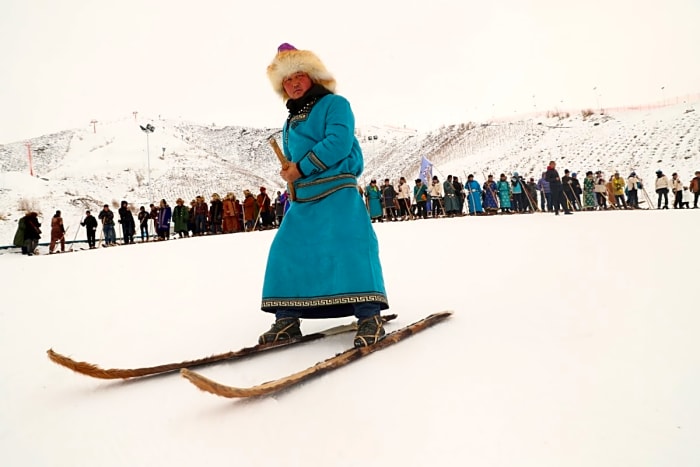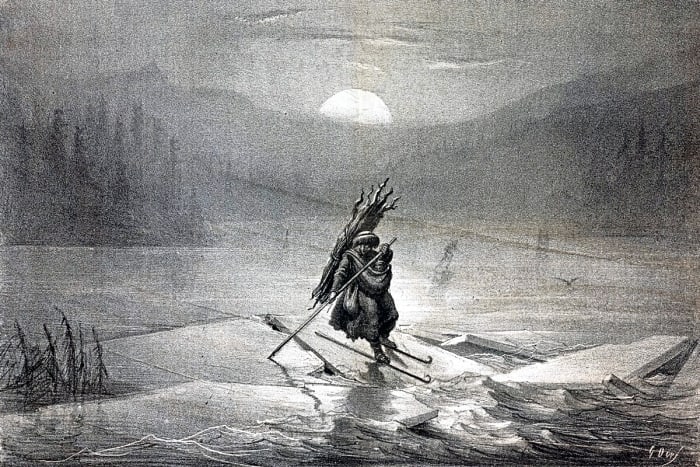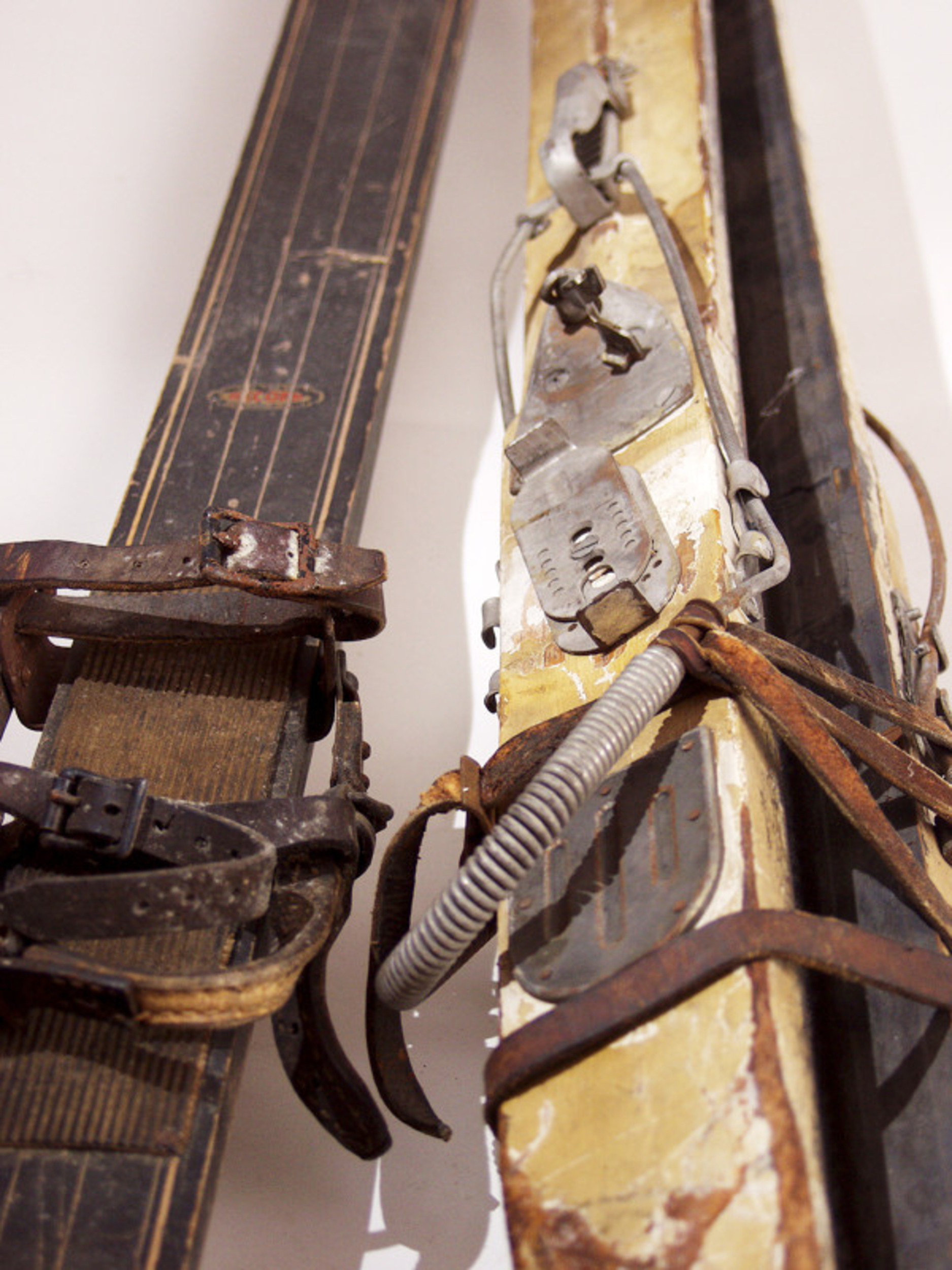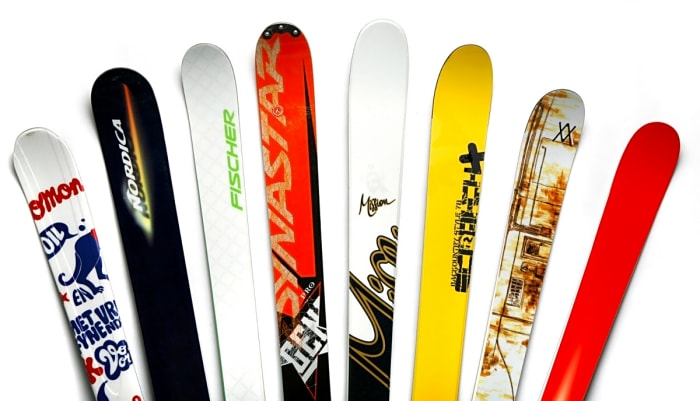Skiing has a long history, and so do the planks we strap ourselves to and slide across snow. From the early days of nomadic Central Asian hunter-gatherers traveling cross-country on skis, to the long tradition of skiing in Scandinavia, our sport has a rich past. Since then, things have come a long way, with the evolution of ski technique warranting the introduction of new materials and shapes in ski design.
Some would say we are living in the golden age of ski design today, with equipment making the sport easier, more enjoyable, and safer than it has ever been, but how much do you actually know about the history of skis?
A trip through the history books (and the archives of POWDER Magazine) may give us some insight.
This piece is part of POWDER's Summer of Ski Nostalgia content series. Stay tuned in daily for more nostalgic articles, and keep an eye out for the upcoming Summer of Ski Nostalgia badge to identify future content.
You can also view all of POWDER's summer nostalgia content here.
Want to keep up with the best stories and photos in skiing? Subscribe to the new Powder To The People newsletter for weekly updates.

Prehistoric Times: Wooden Planks for Cross-Country Travel
As you might have already learned when reading about the history of ski boots, skiing as we know it dates back to about 6000 BC. Historians and archaeologists have found evidence of nomadic tribes using skis to cover snowy ground in Central Asia and Siberia as well as in Scandinavia.
In fact, our word "ski" can be traced back to the old Norse word skíð, which translates to "stick of wood." Most of that evidence exists in the form of cave paintings and carvings, but actual skis have been found that date back to approximately 3200 BC, predating even the earliest wheels.
These early skis actually looked pretty similar to what we ride on today, with an upturned and pointed tip and a sturdy wood construction. The Kalvträsk ski, found in a Norwegian bog in 1924, was made from dense pine wood and featured holes for bindings (likely a leather or cloth strap to bound the foot to the ski's surface).

The Introduction of Skiing as a Sport
Skiing and its equipment took a huge turn when skiers began taking to snowy hills for sport. While it's hard to imagine that skiing wasn't done for fun in its early days, it was mostly used as an overland travel technique for hunting and war. Sometime in the 1700s, skiers began practicing techniques and racing one another for fun. This eventually led to equipment advances like adding camber, shape and reinforcements for bindings.

In fact, up until the early 1900s, many skiers used asymmetrical wooden skis, where one leg would have a short ski with an animal skin on its base for kicking, and the other would have a long, flat ski for gliding. This allowed for efficient cross-country travel but wasn't well-suited for downhill skiing.
Cambered skis and laminate construction ushered in an era of performance that was more appropriate for downhill skiing at speed. Laminated skis, made from multiple layers of wood that were glued together, allowed for stronger and lighter construction and a more predictable flex of the ski.
Better Control Through Metal Edges
One of the next major improvements in ski design came with the introduction of metal edges. This is credited to Austrian skier Rudi Lettner, who saw the need for better edge control after a near-fatal fall, metal edges were introduced to skis in the mid-1920s.
Finding the best way to attach a metal edge to a wooden ski proved challenging however, and early designs often failed catastrophically. In fact, Salomon Skis was first run out of a sawblade factory in Annecy, France, when a young George Salomon convinced his father to re-tool the factory to produce ski edges with a serrated inside to better attach them to the wooden ski. This design soon caught on, and metal edges were here to stay.
Metal, Fiberglass and Other New Materials
Following World War II, the ski industry exploded worldwide, with manufacturers popping up across the United States and Europe at a rapid rate. The growing popularity of skiing as a fun activity led to some serious advances in design.
Metal was first used as a main ingredient in ski construction by Howard Head, an American aircraft engineer who wanted to create a better-flexing ski to make it easier for beginners to get into the sport. Head Skis was the first company to mass produce metal-laminate skis, a manufacturing technique still used across the ski world today.
Soon after, fiberglass entered the fray, as ski manufacturers learned to better use this extremely versatile material. By the late 1960s, fiberglass skis had almost completely replaced metal skis on the market thanks to being lighter and more responsive.
Fat Skis!
By the mid-1980s, skiers were longing for a way to better travel through deep powder snow, and manufacturers began experimenting with wider and wider waist widths. One of the first true "fat" skis was the Atomic Powder Magic, which clocked in at 115mm underfoot. The prototypes were produced by sawing a snowboard in half.
That quickly led to a quiet revolution in ski design, with brands learning that the added float made skiing in deep snow much easier. Shorter lengths also helped skiers initiate turns much easier, but we still hadn't arrived in the era of skis that featured significant sidecut. Instead, imagine skiing on super-fat straight skis!
The Parabolic Ski Era
While there was a quiet revolution happening for soft-snow obsessed skiers, those who spent most of their time on prepared pistes and firm snow were also looking for an edge. For decades, alpine skis had shared a similar form to cross-country skis, with a nearly straight shape and very long lengths. This gave the skis stability at speed, but made carving turns very difficult.
By the late 1980s, brands like Olin, Blizzard, and others started making their skis shorter and adding sidecut to allow a skier to lay the ski over on edge and initiate a turn by pushing through the camber and "bending" the ski.
In 1990, Elan Skis trademarked the term "parabolic" on their Sidecut Extreme (SCX) ski.

Twin Tips and the Freestyle Revolution
As skiing became ever more popular, skiers started pushing the boundaries of the sport, both on the snow and in the air. The New Canadian Air Force, a group of Canadian freestyle skiers, including Mike Douglas, JP Auclair, and several more, saw what snowboarders were doing on snow, and helped usher in the production of the first twin tip skis.
LINE Skis first produced short twin-tipped ski boards, but Salomon was the first to introduce the twin-tip ski when they released the iconic Salomon TenEighty in 1997. Overnight, this revolutionized skiing, by making it easier for riders to ski and land backwards, and kicked off modern freestyle skiing as we know it today.
Shane McConkey and Rockered Skis
Much like how Mike Douglas ushered in the era of twin-tip skis, a young American skier further revolutionized backcountry and big-mountain riding with the invention of reverse-camber and even reverse-sidecut skis. The late Shane McConkey had been experimenting with skiing large water skis in deep snow on Alaskan terrain, proving that reverse camber ("rockered") skis allowed for quick pivoting turns in the three-dimensional medium of powder snow.
McConkey helped release one of the most iconic powder skis of all time, the Volant Spatula, an enormous and very heavy ski that was wider at the waist than at the tip and tail, and featured full reverse camber. Shane McConkey famously issued instructions on how to ski the ski to buyers.
Rocker quickly caught on, with just about every ski maker adding it in some form to their skis. Today, it's nearly impossible to find skis outside of FIS racing that don't have some form of tip or tail rocker in them.
More must-reads:
- Why Bucks can't count on a massive haul for Giannis Antetokounmpo
- Patrick Mahomes challenges Chiefs teammates amid dwindling playoff hopes
- The 'Most passing yards by an NFL rookie' quiz
Breaking News
Trending News
Customize Your Newsletter
 +
+
Get the latest news and rumors, customized to your favorite sports and teams. Emailed daily. Always free!








